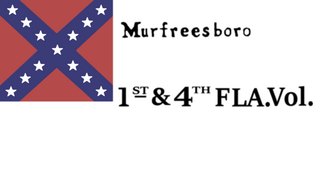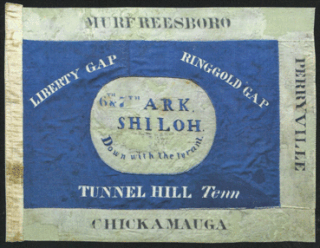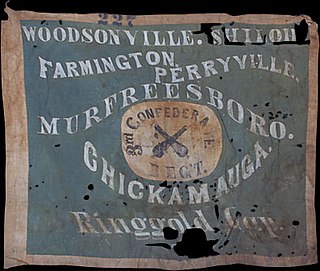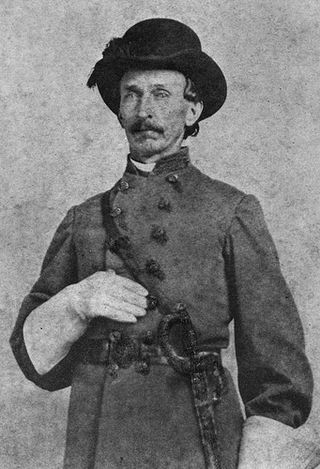The Battle of Greenbrier River, also known as the Battle of Camp Bartow, took place on October 3, 1861 in Pocahontas County, Virginia as part of the Western Virginia Campaign of the American Civil War.
The Battle of Roan's Tan Yard, also known as the Battle of Silver Creek, was a minor battle fought during the American Civil War on January 8, 1862, in Randolph County, Missouri. After back-and-forth operations throughout 1861, the pro-Confederate Missouri State Guard under the command of Sterling Price had been confined to southwestern Missouri. In December 1861, Price authorized recruiting and raiding activities in the central portion of the state, with the North Missouri Railroad being a major target. In January 1862, Major W. M. G. Torrence of the Union Army located a Missouri State Guard base in Randolph County and attacked it on January 8 with elements of four cavalry regiments. The camp, which was commanded by Colonel John A. Poindexter, put up little resistance and was soon overrun. Large quantities of supplies were captured in the abandoned camp, which was destroyed. The action at Roan's Tan Yard, along with a Missouri State Guard defeat at the Battle of Mount Zion Church the preceding December, led to a decrease in pro-Confederate activity in central Missouri.

Florida participated in the American Civil War as a member of the Confederate States of America. It had been admitted to the United States as a slave state in 1845. In January 1861, Florida became the third Southern state to secede from the Union after the November 1860 presidential election victory of Abraham Lincoln. It was one of the initial seven slave states which formed the Confederacy on February 8, 1861, in advance of the American Civil War.

The 1st Florida Cavalry Regiment was a Confederate army unit during the U.S. Civil War, originally organized in July 1861 at Tallahassee. Members of the regiment came primarily from Alachua, Clay, Columbia, Duval, Leon, Levy, Nassau and Suwannee counties. It left for the western theater in 1862.
Hispanics in the American Civil War fought on both the Union and Confederate sides of the conflict. Not all the Hispanics who fought in the American Civil War were "Hispanic-Americans", in other words citizens of the United States. Many of them were Spanish subjects or nationals from countries in the Caribbean, Central and South America. Some were born in a US Territory and therefore did not have the right to US Citizenship. It is estimated that approximately 20,000 Hispanics, mostly Mexican-Americans, Puerto Ricans and Cubans living in the United States joined the war: 2,500 for the Confederacy and 1,000 for the Union. This number increased to 10,000 by the end of the war.

The 7th Arkansas Volunteer Infantry (1861−1865) was a Confederate Army infantry regiment during the American Civil War. Organized mainly from companies, including several prewar volunteer militia companies, raised in northeastern Arkansas, the regiment was among the first transferred to Confederate service, and spent virtually the entire war serving east of the Mississippi River. After the unit sustained heavy casualties in the Battle of Shiloh and the Kentucky Campaign, the unit spent most of the rest of the war field consolidated with the 6th Arkansas Infantry Regiment to form the 6th/7th Arkansas Infantry Regiment.
The 1st Cavalry Regiment, Arkansas State Troops (1861) was an Arkansas cavalry regiment during the American Civil War. The regiment was organized at Camp Walker, near Harmony Springs, Benton County, Arkansas. The regiment was officially designated as the Third Regiment (Cavalry), Arkansas State Troops by the State Military Board, but was designated as the 1st Arkansas Cavalry by Brigadier General Nicholas Bartlett Pearce, Commander, 1st Division, Provisional Army of Arkansas. The regiment is referred to as the "Carroll's Regiment" in contemporary accounts.
The 3d Arkansas Cavalry Regiment (1861–1865) was a Confederate Army Cavalry regiment during the American Civil War.

The 18th Arkansas Infantry (Marmaduke's) (1861–1865) was a Confederate Army infantry regiment during the American Civil War. The unit was also briefly identified as the 1st Arkansas Infantry Battalion. The unit was most often referred to as the 3rd Confederate Infantry Regiment. The designation "Confederate Infantry Regiment" was intended to convey the difference between Provisional Confederate Army units and Regular Confederate Army Units, with Provisional units being those regiments who received a state designation such as "XX Arkansas Infantry Regiment". In practice, the designation was most often utilized when Regiments were assembled utilizing companies from more than one Confederate state. The "3rd Confederate Infantry Regiment" is occasionally misidentified as the 3rd Arkansas Infantry Regiment commanded by Colonel Van H. Manning.

John Jackson Dickison, known as J. J. Dickison, was an officer in the Confederate States Army during the American Civil War. Dickison is mostly remembered as being the person who led the attack which resulted in the capture of the Union warship USS Columbine in the "Battle of Horse Landing". This was one of the few instances in which a Union warship was captured by land-based Confederate forces during the Civil War and the only known incident in U.S. history where a cavalry unit sank an enemy gunboat. Dickison and his men were victorious in all of his raids against the Union troops in Florida, including his raid in Gainesville what is known as the Battle of Gainesville. Tragedy struck Dickison, when one of his sons, both of whom served under his command, was killed during a raid.

Theodore Washington Brevard Jr. was best known for having served as a military officer in the Confederate States Army. During his tenure with the Confederate army, he eventually reached the rank of Brigadier-General. Brevard was captured by the forces of General George Custer and imprisoned at Johnson's Island. He later died in 1882.

The 19th (Dawson's) Arkansas Infantry (1861–1865) was a Confederate Army infantry regiment during the American Civil War. The regiment was present for but not engaged during the Battle of Pea Ridge. At the Battle of Arkansas Post, the regiment became split, with part of the regiment surrendering with the garrison when the post capitulated. The captured portion of the regiment was eventually exchanged and released on the east side of the Mississippi and served the remainder of the war with the Confederate Army of Tennessee. The un-captured portion of the regiment was consolidated with the remnants of the 24th Arkansas and served the remainder of the war in the Department of the Trans-Mississippi.

The 11th Arkansas Infantry Regiment or 11th Arkansas Volunteers was an infantry formation of the Confederate States Army during the American Civil War. Following the units surrender during the Battle of Island No. 10, it was consolidated with Griffith's 17th Arkansas Infantry Regiment and mounted. Following the surrender of Port Hudson, some unit members returned to Arkansas and became part of Poe's Arkansas Cavalry Battalion and Logan's 11th Arkansas Cavalry Regiment.
The 46th Arkansas Infantry (Mounted) (1864–1865) was a Confederate Army Mounted Infantry regiment during the American Civil War. While authorized by the State Military Board as an infantry regiment, the unit was mounted for Price's Missouri Expedition and served as mounted infantry. Due to its mounted status, the unit is sometimes referred to as the 46th Arkansas Cavalry when a numerical designation is used. The unit is almost always referred to as either Coleman's Arkansas Cavalry Regiment or Crabtree's Cavalry in official reports from the period.
The 48th Arkansas Infantry (Mounted) (1864–1865) was a Confederate Army Mounted Infantry regiment during the American Civil War. While authorized by the State Military Board as an infantry regiment, the unit was mounted for Price's Missouri Expedition and was officially designated as mounted infantry. Due to its mounted status, the unit is sometimes referred to as the 48th Arkansas Cavalry when a numerical designation is used.
The 44th Arkansas Infantry (Mounted) (1864–1865) was a Confederate Army Mounted Infantry regiment during the American Civil War. While authorized by the State Military Board as an infantry regiment, the unit was mounted for Price's Missouri Expedition and was officially designated as mounted infantry, but this designation was almost never used by the unit. When a numerical designation is used, the unit is sometimes referred to as the 29th Arkansas Cavalry Regiment. The unit is most often referred as McGehee's Arkansas Cavalry Regiment for its commander, James H. McGehee. McGehee is often spelled McGhee in the Official Records of the Union and Confederate Armies.
The 3rd Missouri Cavalry Regiment was a cavalry regiment of the Confederate States Army during the American Civil War. It was also known as Greene's Regiment after its commander, Colonel Colton Greene.

The 12th Texas Cavalry Regiment was a unit of mounted volunteers recruited in Texas that fought in the Confederate States Army during the American Civil War. The regiment was enrolled in state service in September 1861 and in Confederate service the following month. The regiment fought at Whitney's Lane, Cotton Plant, and L'Anguille Ferry in 1862, Goodrich's Landing in 1863, and Blair's Landing and Yellow Bayou in 1864. The unit also participated in numerous skirmishes and scouts. It disbanded in May 1865.
Colonel John Carraway Smith was an officer in the Confederate States Army during the American Civil War.









